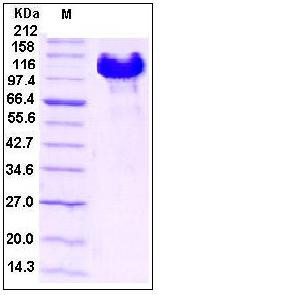Human EphB4 / HTK Protein (Fc Tag)
HTK,MYK1,TYRO11
- 100ug (NPP2109) Please inquiry
| Catalog Number | P10235-H02H |
|---|---|
| Organism Species | Human |
| Host | Human Cells |
| Synonyms | HTK,MYK1,TYRO11 |
| Molecular Weight | The recombinant human EphB4/Fc is a disulfide-linked homodimeric protein after removal of the signal peptide. The reduced monomer consists of 762 amino acids and has a calculated molecular mass of 83.8 kDa. As a result of glycosylation, the rhEphB4/Fc monomer migrates as an approximately 105-115 kDa protein in SDS-PAGE under reducing conditions. |
| predicted N | Leu 16 |
| SDS-PAGE |  |
| Purity | > 95 % as determined by SDS-PAGE |
| Protein Construction | A DNA sequence encoding the extracellular domain (Met 1-Ala 539) of human EphB4 (NP_004435.3) precursor was expressed with the fused Fc region of human IgG1 at the C-terminus. |
| Bio-activity | Measured by its binding ability in a functional ELISA . Immobilized human EFNB2 at 2 μg/ml (100 μl/well) can bind human EphB4-Fc with a linear ranger of 1.56-12.5 ng/ml. |
| Research Area | Epigenetics |Transcription |Cancer susceptibility |Tumor Suppressor |
| Formulation | Lyophilized from sterile PBS, pH 7.4 1. Normally 5 % - 8 % trehalose, mannitol and 0.01% Tween80 are added as protectants before lyophilization. Specific concentrations are included in the hardcopy of COA. |
| Background | Ephrin type-B receptor 4 is a protein that in humans is encoded by the EPHB4 gene. It is a single-pass type I membrane protein belonging to the ephrin receptor subfamily of protein kinase superfamily. Members of the ephrin and Eph family are local mediators of cell function through largely contact-dependent processes in development and in maturity. Furthermore, EphB4 protein and the corresponding ligand Ephrin-B2 contribute to tumor growth in various human tumors. EphB4 protein has tumor suppressor activities and that regulation of cell proliferation, extracellular matrix remodeling, and invasive potential are important mechanisms of tumor suppression. Therefore, Ephrin-B2/EphB4 may be recognized as a novel prognostic indicator for cancers. |
| Reference |
